6 Best Drought-Tolerant Grass Types for Southern California
BY LAUREN BRYANT | MAY 10TH, 2023 | CALIFORNIA, LAWN CAREIn the face of frequent droughts, many SoCal homeowners have had to consider their lawns more. Can their turf survive the hot, dry summers without constant irrigation?
Brown lawns may seem inevitable, but you don’t have to settle for excessive water waste or dead grass. If you choose one of the best drought-resistant grass types for Southern California, you can be more eco-friendly while saving time and money.
In this article, we will cover:
- Warm-Season vs. Cool-Season Grasses
- 6 Best Drought-Tolerant Grass Types for Southern California
- FAQ About Drought-Tolerant Grass Types in Southern California
- Choosing Grass and Plant Varieties for Your Southern California Landscape
Warm-Season vs. Cool-Season Grasses
All turfgrass is categorized into two types: warm-season and cool-season. Warm-season grasses do best in hot southern climates, while cool-season grasses do well in cold northern climates.
Warm-season grasses are a safe bet for most of Southern California. However, you can use cool-season grasses as long as you don’t live in the Southeastern desert regions of the state. Let’s review the crucial differences to narrow down your options.
Warm-Season Grasses
- These grass types actively grow in summer when temperatures are between 80 and 90 degrees Fahrenheit.
- When air and soil temperatures are below 50 to 55 degrees Fahrenheit, warm-season grasses turn dormant and brown.
- Most lawn care needs to be done in spring and summer.
- Plant in late spring or early summer.
- Warm-season grasses tend to be more drought-resistant and less cold-resistant.
Cool-Season Grasses
- These grass types actively grow in spring and fall when temperatures are between 60 and 75 degrees Fahrenheit.
- When air and soil temperatures are below freezing, cool-season grasses turn dormant and brown.
- Most lawn care needs to be done in spring and fall.
- Overseed in fall or spring.
- Cool-season grasses tend to be more cold-resistant and less drought-resistant.
6 Best Drought-Tolerant Grass Types for Southern California
1. Bermudagrass
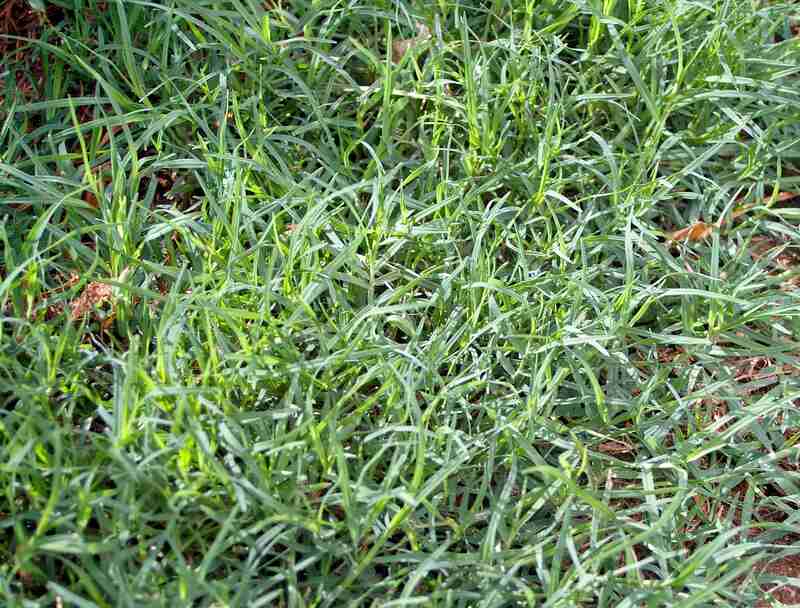
Photo Credit: Bidgee / Wikimedia Commons / CC BY-SA 3.0
This warm-season grass has a medium to coarse texture and a gray-green color. Hybrid varieties have a finer texture and a blue-green to dark green color. You can establish bermudagrass from seeds, sod, or plugs.
Bermudagrass is resilient in the face of disease, heat, foot traffic, and drought. It will require infrequent irrigation, though it benefits from deep watering to develop a healthy root system. Because of its high salinity tolerance, it makes an excellent lawn for coastal properties. It’s also a good choice for families with playful children and pets.
Bermudagrass ranges from low to high maintenance depending on the variety, with hybrids requiring the most fertilization and mowing. It may spread where it’s not wanted due to its aggressive growth, though edging can help. This grass’ worst enemies are shade and cold weather. It will become more vulnerable to weeds and traffic damage under those conditions.
Classification: Warm-season grass
Spreads by: Stolons and rhizomes
Shade tolerance: Poor — needs full sun
Drought tolerance: High
Foot traffic tolerance: High
Maintenance needs: Needs frequent mowing due to fast growth rate; develops thatch easily; needs regular fertilization.
Recommended mowing height: 1-2 inches
Potential for disease: Good resistance to disease, although diseases like spring dead spot are common; low resistance to insects like bermudagrass mites, dichondra flea beetles, and fiery skippers
Soil pH: 6-6.5
Soil type: Tolerates most soil types
Other notes: Bermuda spreads aggressively via its stolons (above-ground stems) and rhizomes (below-ground stems) and can out-compete many weeds. The downside is that it also can be a nuisance and is sometimes considered invasive. You’ll often find it has tunneled underground into flower beds and spread into neighboring lawns.
2. Buffalograss
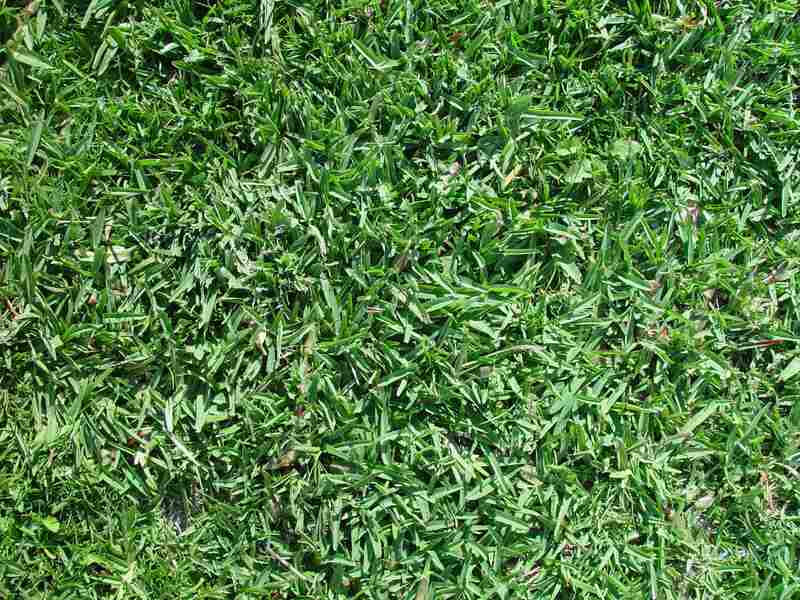
Photo Credit: Titus Tscharntke / Pixnio / CC0
UC Riverside and UC Davis researchers developed the buffalograss cultivar UC Verde to provide more drought-tolerant options for California homeowners. Other varieties can also do well in Southern California, though they may be less drought tolerant. Buffalograss is available in seed, sod, and plug form, while the UC Verde cultivar is only available as plugs.
Buffalograss is low maintenance, requiring little mowing, fertilization, and irrigation. You can mow it every few weeks or leave it unmowed for a meadow-like appearance. Its water needs are less than half of other common grass types, including bermudagrass and tall fescue. Once established, it can hold its own against weeds, diseases, and pests.
Like many warm-season grasses, buffalograss doesn’t handle shade or cold weather well. It will turn brown at the first sign of frost or if not watered for long periods in summer. To keep a buffalograss lawn green in winter, use biodegradable green dye or overseed with annual ryegrass. Buffalograss’ light to grayish-green color may not appeal to everyone. The expensive seeds and sod also can be a deterrent.
Classification: Warm-season grass
Spreads by: Stolons
Shade tolerance: Very low — best suited for full sun
Drought tolerance: High
Foot traffic tolerance: Very low, but light use or rare heavy use is OK
Maintenance needs: Low mowing frequency — once per week or less
Recommended mowing height: 2-4 inches or leave unmowed; UC Verde doesn’t grow taller than 4-6 inches
Potential for disease: Good tolerance against diseases and insects
Soil pH: 6.5-7.5
Soil type: Prefers soils that aren’t sandy
Other notes: Buffalograss often turns brown in winter. Because of its few flowerheads, it produces little pollen and seeds, making it suitable for those with allergies.
3. Kikuyugrass
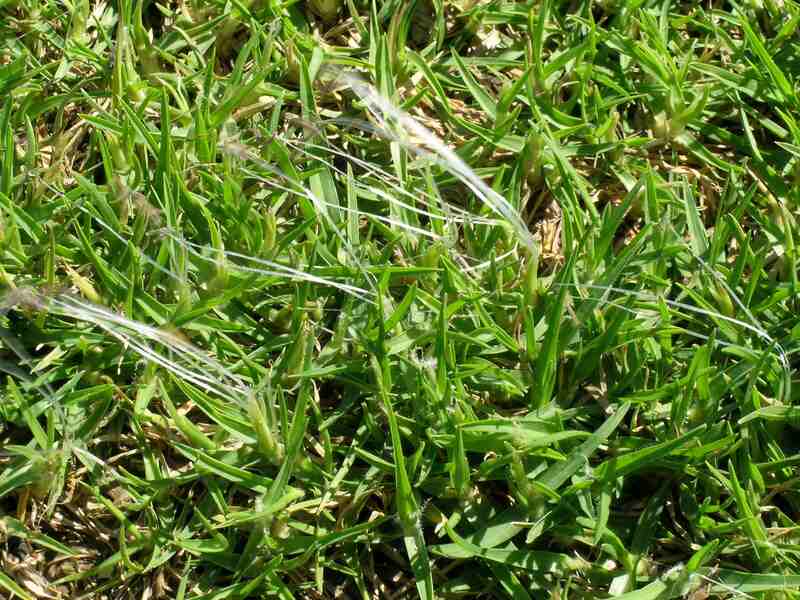
Photo Credit: Harry Rose, Macleay Grass Man / Wikimedia Commons / CC BY-SA 2.0
This East African grass has a coarse texture and light green color, similar to St. Augustinegrass. Though it is not a common turfgrass choice in California, kikuyugrass has gained popularity over the years.
This low-maintenance grass isn’t very susceptible to disease. It thrives in moderate temperatures but also can handle heat and drought. You can plant kikuyugrass in moderate shade and low-fertility soils. Its aggressive growth allows it to recover from wear and tear quickly.
Why isn’t kikuyugrass more popular for lawns? Due to its aggressive growth, this grass is considered a weed in many parts of coastal and inland California. Its rapid growth makes it prone to thatch, making mowing difficult. You’ll need to mow frequently to keep up with growth and avoid scalping damage. Remember that kikuyugrass is susceptible to cold and will go dormant in winter.
Classification: Warm-season grass
Spreads by: Rhizomes and stolons
Shade tolerance: Moderate
Drought tolerance: High
Foot traffic tolerance: High
Maintenance needs: Low
Recommended mowing height: 1-1.5; it’s vulnerable to scalping damage if it isn’t mowed frequently
Potential for disease: Low
Soil pH: 5.5-7
Soil type: Fertile, moderately drained soils with a light to medium texture; can tolerate low fertility
Other notes: This grass type is native to East Africa and was imported to California to help with erosion. Its aggressive growth makes it more resilient but makes many consider it a weed. It develops thatch easily.
4. Zoysiagrass
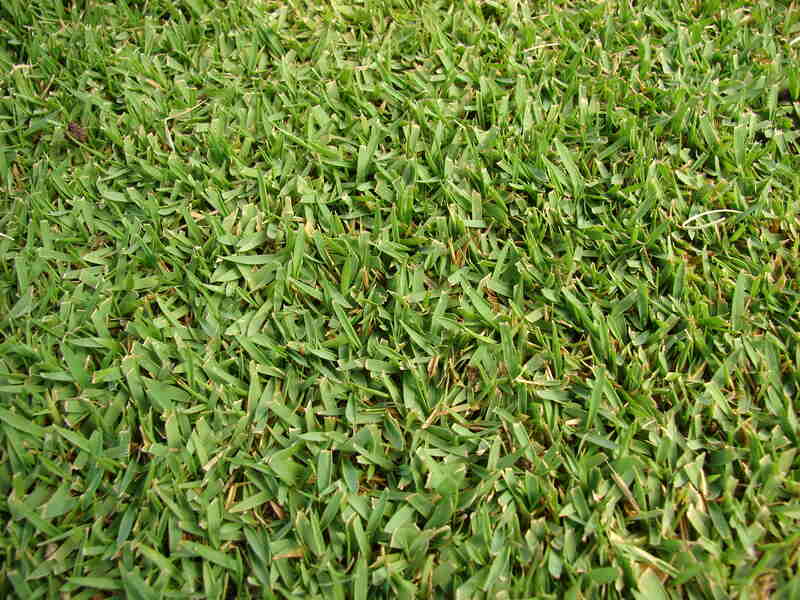
Photo Credit: Forest & Kim Starr / Wikimedia Commons / CC BY-SA 3.0
Native to Asia, Zoysiagrass is dark green with a fine to medium texture. It creates a dense, prickly turf once established.
This low-maintenance grass is well-adapted to warm climates. Not only can it survive drought and high heat, but it also holds up well to foot traffic. The only major pest it deals with is nematodes. It will require little fertilizer and a moderate amount of mowing. Though Zoysiagrass prefers full sun, you can plant it in a yard with partial shade.
One downside of Zoysiagrass is its slow establishment. As a result, many homeowners choose to skip seeds and use Zoysiagrass sod or sprigs. Its density also poses a challenge, making it difficult to mow. Zoysiagrass lawns become dormant in winter, but you can improve their color with fall fertilization.
Classification: Warm-season grass
Spreads by: Stolons and rhizomes
Shade tolerance: Tolerates light to moderate shade
Drought tolerance: High
Foot traffic tolerance: High
Maintenance needs: Low to moderate nitrogen requirement; moderate mowing frequency
Recommended mowing height: 1-2.5 inches
Potential for disease: Not prone to disease and insects; good disease tolerance overall; watch out for nematodes
Soil pH: 6-6.5
Soil type: Well-draining; some cultivars more tolerant of a wide range of soils than others
Other notes: Moderately salt tolerant; cut with sharp mower blade; mow taller if the grass is in partial shade
5. California Native Bentgrass
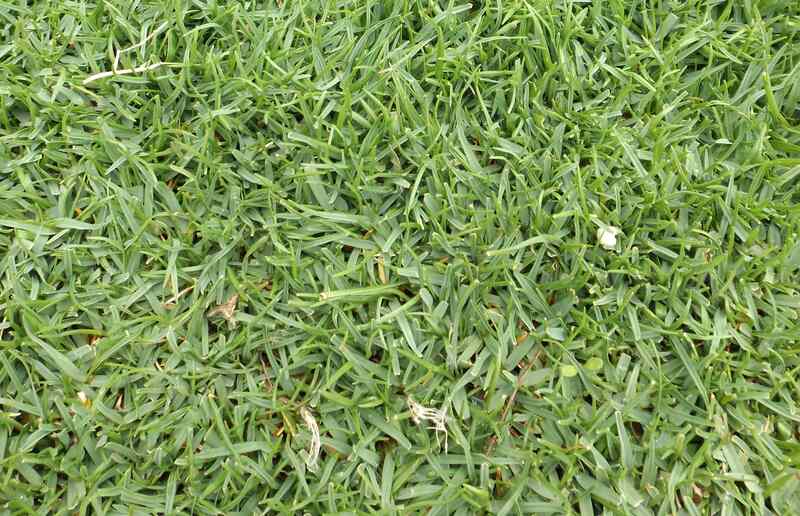
Photo Credit: Ruff tuff cream puff / Wikimedia Commons / CC0 1.0
Though there are many types of bentgrass, it’s no surprise that California native bentgrass is well adapted to drought conditions. This species is also called seashore bentgrass, thingrass, or Agrostis pallens. It has uniform growth, a medium texture, and deep green color. Some consider it a turfgrass alternative, but you can still make it into a traditional lawn.
Seashore bentgrass requires half the water of typical cool-season grasses and can stay green year-round. Its self-repairing rhizomes allow it to bounce back from damage. This grass naturally grows from around 4 to 28 inches. You can cut it short or keep it long for a meadow-like appearance. Remember, you can’t go straight from shaggy lawn to close-cut turf, or you could damage the grass. Lower the height gradually if you want to switch.
Because of its slow establishment and growth rate, seashore bentgrass sod is expensive. As the name suggests, this grass type is best suited for coastal areas. It doesn’t do well in the central valley or the California deserts.
Classification: Cool-season grass
Spreads by: Rhizomes
Shade tolerance: Prefers full sun
Drought tolerance: High
Foot traffic tolerance: Moderate
Maintenance needs: Low; you can mow it or let it grow out
Recommended mowing height: 1.5-2 inches
Potential for disease: High
Soil pH: 5-8
Soil type: Any soil with good drainage
Other notes: This grass can be mowed or left long and meadow-like. It is best suited for coastal areas.
6. Tall Fescue
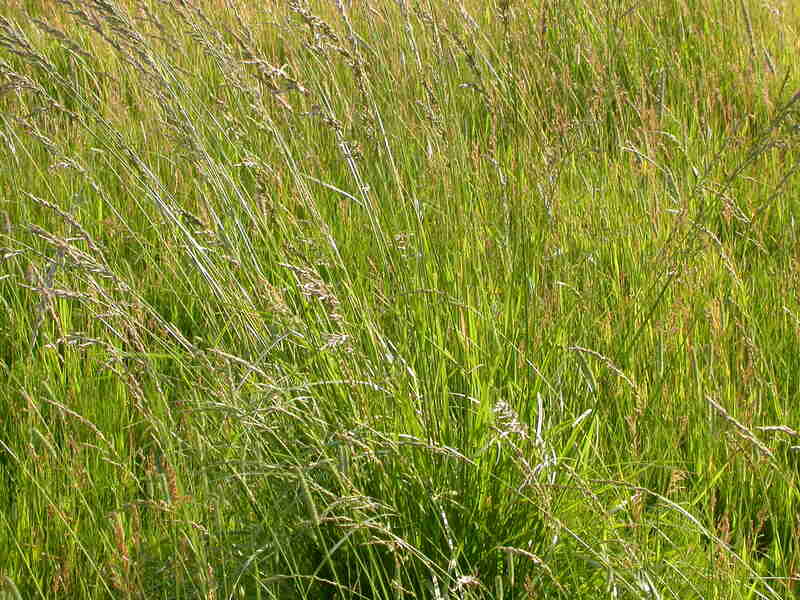
Photo Credit: Matt Lavin / Flickr / CC BY-SA 2.0
This cool-season grass is one of the most common lawn grasses in California. Tall fescue is dark green with a moderate to coarse texture. Turf-type tall fescues and dwarf turf-type tall fescues are shorter with a finer texture.
Tall fescue is generally low-maintenance, with little watering required. Sow densely for a uniform lawn and good weed and disease resistance. It also handles moderate traffic well. Tall fescue will stay green in warm and cool weather if neither is too extreme. It handles heat and drought stress well due to its extensive root system. Plant it in the sun or partial shade.
Tall fescue’s bunch-type growth pattern means it won’t repair bare patches on its own. Reseed thin or patchy lawns to improve their appearance and performance. Though it does well in many parts of the state, it’s unsuitable for high-altitude areas.
Classification: Cool-season grass
Spreads by: Bunch-type grass
Shade tolerance: Moderate
Drought tolerance: Moderate
Foot traffic tolerance: Moderate, but low ability to recuperate from wear
Maintenance needs: Fast rate of growth, so plan to mow often
Recommended mowing height: 2-4 inches (many tall fescue lawns grow best when they’re mowed on the tall side); do not mow less than 1.5 inches
Potential for disease: Low to moderate under proper management conditions
Soil pH: 5.5-6.5
Soil type: Fertile, good drainage, but will tolerate a wider range of soil conditions
Other notes: Reseed every few years to repair bare spots and thinning; don’t plant old varieties such as Kentucky-31; look for “turf-type” tall fescue (TTTF). Seed blends with more than one TTTF cultivar give the best chance for a strong lawn.
FAQ About Drought-Tolerant Grass Types in Southern California
The best no-mow grass types are UC Verde buffalograss and native California bentgrass. You can let either grow out into a natural-looking meadow. If you revert to a shorter height, gradually bring the mowing height down and never cut off more than one-third of the grass’ blade at once.
If you want traffic tolerance, the most durable grass types are bermudagrass, kikuyugrass, and Zoysiagrass. Each can handle playful dogs, energetic children, and backyard parties without falling into ruin. Remember that all grass types can be damaged with excessive or rough use. However, these grass types stand the best chance of resistance and recovery.
The best grass types for full sun are bermudagrass, buffalograss, and native California bentgrass. These types prefer full sun and may not do well in the shade. Zoysiagrass also does well in full sun, but it will tolerate more shade than the others.
Choosing Grass and Plant Varieties for Your Southern California Landscape
A water-efficient lawn is only one component of drought-resistant landscaping. When paired with plants native to Southern California, your yard could save you water, time, and money. It also will be more fire-resistant.
If you need assistance revamping your lawn or other landscaping, let Wikilawn connect you with local pros. You can find lawn care and landscaping companies in Long Beach, Santa Ana, Riverside, and many more SoCal cities.
Main Image Credit: UCLA / Josh Lee / Wikimedia Commons / CC BY-SA 3.0